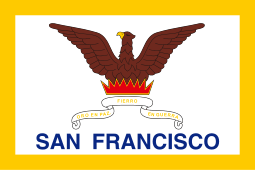Flag of San Francisco
 | |
| Use | Civil flag |
|---|---|
| Adopted | December 16, 1940 |
| Design | A white field, with a phoenix rising from flames. There is a motto beneath the phoenix on a ribbon, "Oro en paz. Fierro en guerra." |
The flag of the City and County of San Francisco, which depicts a rising phoenix, is often assumed to be symbol of the city's recovery from the 1906 earthquake and subsequent fires. However, the flag itself dates several years earlier to around 1900. It was officially adopted as the flag of San Francisco on December 16, 1940.
History
.png)

In 1900, banker and art patron Mayor James Duval Phelan, mayor from 1897 to 1902, recommended to the Board of Supervisors that San Francisco adopt a flag and motto. Over 100 designs were submitted and John M. Gamble's proposal was selected. It depicts a phoenix rising from its ashes on a white field. The mythological phoenix appears in many ancient cultures and is a symbol of immortality. When the long-lived phoenix feels death is near, it builds a nest of aromatic wood and sets it afire. A new phoenix then arises from the ashes, just as San Francisco arose from the great fires of the 1850s. The motto "Oro en paz y fierro en guerra" "Gold in Peace and Iron in War" refers to the city's then-recent experience during the Spanish–American War as the embarkation point for troops to the Philippines in 1898.[1]
Design
Below the phoenix is a banner which reads in Spanish, Oro en Paz—Fierro en Guerra (English: "Gold in Peace, Iron in War"). Because of this, the official city colors are gold and black; these two colors decorate the dome of San Francisco City Hall.
The yellow border, now reproduced as a part of the flag was originally intended to be a gold fringe, but mistakenly became incorporated into the design. When used indoors, as is the custom, a gold fringe is added to what was originally intended to be the fringe.
See also
References
- ↑ Caption from the "War & Dissent: The U.S. in the Philippines, 1898-1902" exhibit. Curated by Randolph Delehanty, Ph.D. of the Presidio Trust.
